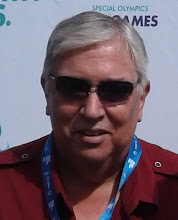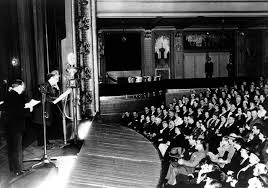Guitarchestra: The Way It Was, 30 March
FEATURED BROADCAST
THE LES PAUL SHOW:
AUDITION SHOW
(NBC, 1950)
THE LES PAUL SHOW:
AUDITION SHOW
(NBC, 1950)
The virtuoso guitarist and recording technologist auditions what proves to be a short-lived---musically memorable, otherwise often-enough lacking---fifteen-minute radio program featuring himself, his then-wife Mary Ford (vocals), and their collaborator Eddie Stapleton (percussion, occasional bass). With a factual correction here and there, what follows is a review of the show I wrote in late 2006:
----------
LES PAUL: Hello, hello everyone, this is Les Paul speaking, and with me I have mawife Mary—--
MARY FORD: Hi!
PAUL: —--and my git-tar. Uhhh . . . for the benefit of any new listeners who may have just tuned in, I’d like to mention that this program comes from our home, and that I have a room here just loaded with electronic gadgets—--amplifiers, echo chambers, transformers, six L-6s—--
FORD: Let me tell ‘em, Les, you’re a genius.
PAUL: Aw, don’t say that—
FORD: Oh, yes, you are—
PAUL: You’re embarrassing me—--a
FORD: Anyone who can take one guitar and make it sound like six is a genius.
PAUL: Any guy can do the same thing.---The Les Paul Show, 11 July 1950, NBC.
Never mind whether the couple was scripted or winging it, and the chances were pretty good that it was half and half.
FORD: Oh, no one else can even play like you, much less make it sound like six people.
PAUL: Well, I—--all I like to do is get on the floor with a screwdriver and some tools and tinker around.
FORD: Aww, but you’re really a genius.
PAUL: No, I’m just a big tinker.
FORD: O-K, you’re just a big tinker.
PAUL: Oh. (Pause.) I shoulda quit when I was ahead.
Any guy could do the same thing assuming a) he could play a guitar in the first place (for the uninitiated: L-6s refers to the Gibson guitar Paul played and modified in 1950, before he and Gibson developed the model that has since borne his name), and b) he paid close enough attention after Les Paul showed any guy that you could make yourself a guitarchestra in the first place, never mind how to do it in the first place.
In broadcast terms, Les Paul and Mary Ford are probably remembered better for seven years’ worth of television’s Les Paul and Mary Ford at Home than one or two year’s worth of The Les Paul Show. A little prowling reveals the radio show ran two years with a decent share snaking around in mp3 files (and an episode or three included on the Capitol Records box anthology, The Legend and the Legacy). A little listening reveals a lot of gently off-the-wall fun and a passel of music that was futuristic at the time, remains intriguing even today, and often sounds years beyond its time still.
On the show transcribed above, it went from that homey little exchange to a Paulist take of “Sweet Georgia Brown.” Paul had created a system known puckishly as the Les Paulverizer, a recording machine that essentially multiplied what it was fed, enabling Paul to dub himself on the spot if he chose to do so, within reason. “Sweet Georgia Brown” got a multitracking treatment not dissimilar to the treatment through which his earlier version of “Lover” became a futuristic hit record, complete with recording acceleration pressing a pre-cut guitar harmony into a speed-of-light arpeggio flying counterpoint above the chorus, before a deceleration that had the feel of a roller coaster nudging the brakes gently rather than slamming them down from the final drop.
PAUL: Mary, I got a hunch that if I could take one guitar and make it sound like six guitars, I can make your voice—my wife—sound like six people.
FORD: That sounds like my husband—he eats like six people.
PAUL: But I’m your husband.
FORD: Which reminds me—if you don’t get a screwdriver and put that plug back in the electric stove . . . well, no cookin’.
PAUL: Oh, you don’t mean that all I’ve go—
FORD: I can’t give you anything but love.
PAUL: Well, that’s our cue for the next song.
From which point Paul would flip on the Paulverizer and turn Ford—--who bore an unsophisticated but pleasant voice, and could hold her own with any pop singer of the time--—into a harmony group. Here her take of “I Can’t Give You Anything But Love” was calmly affecting in front of her husband’s sympatico guitars. (The couple divorced in 1963; the apparent wedge was her wish to back away from work and his need to keep working.)
Paul in the 1940s had a tandem reputation as a clever country picker (he did morningtime country broadcasts as Red Hot Red early in the 1940s) and a fluid, bluesy jazz improvisor (he was brought in, last minute, to the first Jazz at the Philharmonic concert, in 1944, and swapped solos nothin’-to-it-folks with the like of Illinois Jacquet) even before Bing Crosby put him on the air (supporting Crosby’s own show) and on shellac (that was Paul’s distinctive chord-and-run backing Der Bingle’s “It’s Been a Long, Long Time,” among others). His Les Paul Trio recordings of the era (recently remastered/reissued) stood up to any other guitarist’s, including Charlie Christian’s.
Remove his technological toying and all you would have left is a remarkable musician anyway. You can’t dismiss him as merely Mr. Wizard. Not even his most transdimensional experiments obscured Les Paul’s swing, whether he sent himself into outer space or fifty fathoms beneath the waves—--and his treatments often put him into both places at once. “Little Rock Getaway,” whether the version he cut as a Capitol single (with one alternate guitar line treated to resemble a staccato harpsichord) or the version he produced for the 26 May 1950 Les Paul Show (without the staccato-harpsichord treatment), only begins to illustrate the point.
Paul and Ford on the radio presented warmly enough, though their humour today seems of a place between cornpone quaint and clumsy off-guard stiff. But there's a humanness enough to it even when it resembles a kind of obligato in return for getting to deliver their futuristic music their way once a week on the air. (And, for Paul perhaps trying to make a case for "Nola" as one of his favourite songs---he led off the audition show and two regulation installments with the song. Good thing his rendition is so charming, though if I were going to choose a threepeater I'd have gone for his ripsnorting version of "The Carioca.")
Separate the songs from the banter and create a terrific Les Paul and Mary Ford album---you can treat the material into which they made hits as worthy alternate takes. Leave it all alone and have a pair (or trio, whenever percussionist/bassist Stapleton joined up) of guitarchestra-packing, warmhearted houseguests whose only lack is better comedy writers.
PAUL: Hi, folks.
SFX: (workshop sounds--tapping, hammering, etc.)
PAUL: Mary, would you hand me that pipe wrench?
SFX: (ringing clank)
FORD: Here.
PAUL: Uh, that's my wife, Mary.
FORD: Thanks.
PAUL: All right, stand back. I'm gonna turn it on.
SFX: (small whooshing gas jet)
FORD: That letter from the gas company sure started something . . . (SFX: continuing small hissing gas jet) . . . Of all the guitar players in the world, I had to pick someone who isn't satisfied with an electric guitar. He has to build the first gas guitar.
SFX: (continuing small hissing gas jet)
PAUL: Say, would you hand me the screwdriver?
FORD: Here's a screwdriver.
PAUL: Uh---oil rag?
FORD: Oil rag.
PAUL: Monkey wrench?
FORD: Monkey wrench.
PAUL: Match?
FORD: Death certificate.
Assuming they had regular writers, they must have had the night off.
AIRWAVES . . .
1922---A pair of radio stations hit the air running today, both with foundations in the religious community---KGY in Olympia, Washington, whose call letters are received formally a month later by Benedictine monk Sebastian Ruth, and whose life begins as a small St. Martin's College operation before moving to formal studios in 1925; and, WWL at Loyola University of New Orleans, where the Jesuits at the university were required to obtain Vatican approval before they could operate a radio station, and whose first known program is a piano recital.
Both stations become national network affliates in 1935: KGY to Mutual Broadcasting System, and WWL to CBS.
CHANNEL SURFING . . .
LUX RADIO THEATER: STABLEMATES (CBS, 1941)---An adaptation of the 1938 film based loosely on the famous Hollywood Gold Cup race won by Seabiscuit, in which Doc Perry (Wallace Beery)---up against would-be race fixers to treat a stricken thoroughbred---finds his self-respect again with the help of earnest exercise boy Jimmy Donnelly (Mickey Rooney). Mrs. Shepherd: Fay Wray. Donovan: Noah Beery. Beulah: Verna Felton. Track Announcer: Lou Merrill. Host/producer: Cecil B. De Mille. Adapted from the screenplay by Richard Maibaum and Leonard Praskins, from a story by Reginald Owen and Wilhelm Thiele.
FIBBER McGEE & MOLLY: VOTING FOR A CONGRESSMAN (NBC, 1954)---The incumbent's been picked for the state Supreme Court, leaving Wistful Vista to a special election to pick his successor . . . and Molly (Marian Jordan, who also plays Teeny) asking Fibber (Jim Jordan) to elaborate on the four candidates. (And, deliver a classic definition of "filibuster.") Doc Gamble: Arthur Q. Bryan. Writers: Phil Leslie, Ralph Goodman.
PREMIERING TODAY . . .
1892---Ethel Owen (actress: Against the Storm, Mary Noble, Backstage Wife), Racine, Wisconsin.
1893---Dennis Hoey (actor: Pretty Kitty Kelly), London.
1913---Frankie Laine (as Francesco Paolo LoVecchio; singer: The Big Show), Chicago.
1919---Turhan Bey (actor: The Notorious Tarique), Vienna.
1926---Bill Farrell (singer: The Bob Hope Show), Cleveland.
1927---Peter Marshall (as Ralph Pierre LaCock; actor: Hollywood Radio Theatre), Huntington, West Virginia.
1929---Richard Dysart (actor: We Hold These Truths), Augusta, Maine.
1930---John Astin (actor: Zero Hour), Baltimore.
1893---Dennis Hoey (actor: Pretty Kitty Kelly), London.
1913---Frankie Laine (as Francesco Paolo LoVecchio; singer: The Big Show), Chicago.
1919---Turhan Bey (actor: The Notorious Tarique), Vienna.
1926---Bill Farrell (singer: The Bob Hope Show), Cleveland.
1927---Peter Marshall (as Ralph Pierre LaCock; actor: Hollywood Radio Theatre), Huntington, West Virginia.
1929---Richard Dysart (actor: We Hold These Truths), Augusta, Maine.
1930---John Astin (actor: Zero Hour), Baltimore.












0 Comments:
Post a Comment
Subscribe to Post Comments [Atom]
<< Home